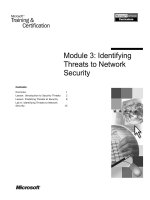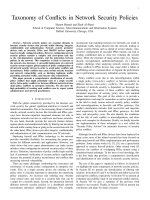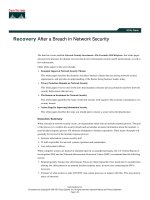Event correlation in network security to reduce false positive
Bạn đang xem bản rút gọn của tài liệu. Xem và tải ngay bản đầy đủ của tài liệu tại đây (803.93 KB, 5 trang )
ISSN:2249-5789
Anita Rajendra Zope et al , International Journal of Computer Science & Communication Networks,Vol 3(3),182-186
Event Correlation in Network Security to Reduce
False Positive
Mrs.Anita Rajendra Zope, Prof. D.R.Ingle
Abstract—As the network based computer system plays an
important role in modern society they have become target of our
enemies and criminals. Therefore we need to find the best
possible ways to protect our IT System. Different methods and
algorithms are developed and proposed in recent years to
improve intrusion detection systems. The most important issue
in current systems is False Positive alarm rate. This is because
current systems are poor at detecting novel anomaly attacks.
These kinds of attacks refer to any action that significantly
deviates from the normal behavior which is considered
intrusion. Many NIDSs are signature based which consider only
one device log, and conclude whether intrusion happened or not
and internet attacks are increasing exponentially and there have
been various attacks methods, consequently. This paper gives
an overview of data mining field & security information event
management system. We will see how various data mining
techniques can be used in security information and event
management system to enhance the capabilities of the system.
we can use Data mining using Event Correlation Technique
(ECT) for Network Intrusion Detection such thatby correlating
events at different component of network security NIDS can
identify whether actually intrusion occurred or not.
Index Terms—Data mining, security information event
management system.
I.
INTRODUCTION
In many industries computer network play an important role
for information exchange, example tender quotations or for
sending confidential information computer networks re most
preferred. And so they have become the targets of our enemies
and criminals. Therefore, we need to find the best ways
possible to protect our systems. When Intrusion occurs
security of system compromised. An intrusion can thus be
defined as “any set of actions that attempt to compromise the
integrity, confidentiality, or availability of a resource”.
Intrusion prevention techniques, such as user authentication
(e.g., using passwords or biometrics), avoiding programming
errors, and information protection (e.g., encryption) have been
used to protect computer systems as a first line of defense.
Firewall is one way to detect any malaises activity where the
packets are analyses and discarded on the basis of the policies
that are defined by the Network Administrator .But use of only
firewall to defend is not good solution so the Intrusion
Detection Systems IDS are now used for Intrusion detection
rather than only firewall. Detection don’t do anything to avoid
or take any action to remove that problem but simple detect an
intrusion and generate an alarm or sometime take first aid like
block the IP address of the system from where any malicious
packet came from. Data mining derives its name from the
similarities between searching for gold in mines. Data mining
is becoming increasingly common in both the private and
public sectors. Industries such as banking, insurance,
medicine, and retailing commonly use data mining to reduce
costs, enhance research, and increase sales [2].If scope of data
mining is applied to all events logs generated by various
networking devices , system and application servers then
efficiency of enterprise security can be drastically increased.
II. INTRUSION DETECTION SYSTEM
Intrusion Detection Systems (IDS) are security tools that, like
other measures such as antivirus software, firewalls and access
control schemes, are intended to strengthen the security of
information and communication systems .It is a device or
software application that monitors network and/or system
activities for malicious activities or policy violations and
produces reports to a Management Station [2]. Although
intrusion detection technology is immature and should not be
considered as a complete defense, but at the same time it can
play a significant role in overall security architecture. If an
organization chooses to deploy an IDS, a range of commercial
and public domain products are available that offer varying
deployment costs and potential to be effective. Because any
deployment will incur ongoing operation and maintenance
costs, the organization should consider the full IDS life cycle
before making its choice. When an IDS is properly deployed,
it can provide warnings indicating that a system is under
attack, even if the system is not vulnerable to the specific
attack [3]. These warnings can help users alter their
installation’s defensive posture to increase resistance to
attack. In addition, IDS can serve to confirm secure
configuration and operation of other security mechanisms
such as firewalls. Within its limitations, it is useful as one
portion of a defensive posture, but should not be relied upon
as a sole means of protection. As e-commerce sites become
attractive targets and the emphasis turns from break-ins to
denials of service, the situation will likely worsen.
Host Based IDS(HIDS)
Its data come from the records of various host activities,
including audit record of operation system, system logs,
application pro-grams information, and so on.
Network Based IDS(NIDS)
A Network Intrusion Detection System (NIDS) is an intrusion
detection system that tries to detect malicious activity such as
denial of service attacks; port scans or even attempts to crack
into computers by monitoring network traffic. A NIDS reads
all the incoming packets and tries to find suspicious patterns
known as signatures or rules. If, for example, a large number of
182
ISSN:2249-5789
Anita Rajendra Zope et al , International Journal of Computer Science & Communication Networks,Vol 3(3),182-186
TCP connection re-quests to a very large number of different
ports are observed, one could assume that there is someone
conducting a port scan of some or all of the computer(s) in the
network. Its data is mainly collected network generic stream
going through network segments, such as: Internet packets [5]
Another classification of intrusion detection is,
Anomaly Based IDS
Anomaly detection consists of first establishing the normal
behavior profiles for users, programs, or other resources of
interest in a system, and observing the actual activities as
reported in the audit data to ultimately detect any significant
deviations from these pro-files. Most anomaly detection
approaches are statistical in nature. Anomaly detection
systems can detect unknown intrusion since they require no a
priori knowledge about specific intrusions. Statistical based
approaches also have the added advantage of being adaptive to
evolving user and system behavior since updating the
statistical measures is relatively easy. Shortcomings of this
type are , The selection of the right set of system (usage)
features to be measured can vary greatly among different
computing environments; The fine tuning of the deviation
threshold is very ad hoc; User behavior can change
dynamically and can be very inconsistent.
Existing NIDS
First major work in the area of intrusion detection was
discussed by J.P Anderson. Concept that is introduced by that
was as certain types of threats to the security of computer
systems could be identified through a review of information
contained in the system’s log. This system log is available in
many types of operating systems, particularly the various
“flavors” of UNIX; automatically create a report which details
the activity occurring on the system. Anderson identified three
threats which could be identified from a concentrated review
of the audit data:
External Penetrations- Unauthorized users of the
system
Internal Penetrations- Authorized system users who
utilize the system in an unauthorized manner.
Misfeasors - Authorized user who mislead their access
privileges [6]
Numbers of IDS are available in market, it’s best to use a Web
search to locate current products, reviews, and so forth.
Commercial product literature is generally weighted towards
marketing, which often makes it difficult to determine the
product’s functionality and detection approach. Virtually no
commercial literature addresses issues such as the frequencies
of false alarms, missed detections, or the system’s sensitivity
to traffic loads.
Shadow and Snort
Two public-domain ID tools, are unlikely to have the same
level of support as commercial systems, so users will need a
higher level of technical expertise to install and manage them.
The effort involved is likely to pay off with a better
understanding of ID and its strengths and limitations. Sensors
usually reside at key monitoring points in the network, such as
outside a firewall, while the analysis station resides inside the
firewall. The sensor is based on public domain packet-capture
software and does not pre-process the data, thus preventing an
intruder from determining the detection objectives by
capturing an unprotected sensor. Sensors extract packet
headers and save them to a file that the analysis station
reads periodically. The analysis station uses a Web-based
inter-face to display filtering results as well as raw data.
Shadow runs on many UNIX systems and Linux. Snort is a
recent open-source public domain effort to build a
lightweight, efficient, ID tool that can be deployed on a wide
variety of UNIX platforms. According to the Snort Web site
(www.snort.org), views are quickly outdated. The
“Technology” sidebar describes a sample of commercial,
research, and public domain tools. Snort is a lightweight
network intrusion detection system, capable of performing
real-time traffic analysis and packet logging on IP networks. It
can perform protocol analysis, content searching/ matching
and can be used to detect a variety of attacks and probes, such
as buffer overflows, stealth port scans, CGI attacks, SMB
probes, OS fingerprinting attempts, and much more. Snort
uses a flexible rules language to describe traffic that it should
collect or pass, as well as a detection engine that utilizes a
modular plug-in architecture. Snort is currently undergoing
rapid development. The user community is contributing
auxiliary tools for analyzing and summarizing snort logs,
providing additional capabilities. More importantly, there is a
large group of users who contribute new signatures. As a
result, new attacks are quickly represented in the signature
database [3].
Problems in Current intrusion Detection System
We measure the quality of IDS by its effectiveness,
adaptability and extensibility. An IDS is effective if it has both
high intrusion detection (i.e., true positive) rate and low false
alarm (i.e., false positive) rate. System is adaptable if it can
detect slight variations of the known intrusions, and can be
quickly updated to detect new intrusions soon after they are
invented. It is extensible if it can incorporate new detection
modules or can be customized according to (changed) network
system configurations. Current IDSs lack effectiveness. The
hand-crafted rules and patterns, and the statistical measures on
selected system measures are the codified “expert knowledge”
in security, system design, and the particular intrusion
detection approaches in use. Expert knowledge is usually
incomplete and imprecise due to the complexities of the
network systems. Current IDSs also lack adaptability. Experts
tend to focus on analyzing “current” (i.e., “known”) intrusion
methods and system vulnerabilities. As a result, IDSs may not
be able to detect “future” (i.e., “unknown”) attacks.
Large amount of Data
Another aspect which does not relate directly to misuse
detection but is extremely important is how much data an
analyst can efficiently analyze. That amount of data he needs
to look at seems to be growing rapidly. Depending on the
intrusion detection tools employed by a company and its size
there is the possibility for logs to reach millions of records per
day [8].
False positives: is the amount of false positives IDS will
generate. A false positive occurs when normal attack is
mistakenly classified as malicious and treated accordingly.
and knowledge. Consequently, data mining has enormous
that human cannot process it fast enough to get the Data
mining for security applications
183
ISSN:2249-5789
Anita Rajendra Zope et al , International Journal of Computer Science & Communication Networks,Vol 3(3),182-186
In this section we will understand what is role of data
mining in security information & event management system.
III. DATA MINING AND EVENT CORRELATION
SIEM system uses data feeds from various devices.
Fig. 1. SIEM Architecture
.
SIEM Architecture has four major parts:
1) Data Sources : SIEM system gets data feed from various
devices which not only include networking devices but
also some physical security devices like bio metric
devices, card readers.
2) Data Collectors: primary function of data collector is to
do normalization. This normalization happens in two
ways it first normalize the values such as time zone,
priority, severity in to common format, then they
normalize the data structure in to common format. Some
time collector do aggregation for example if there are 5
similar events in less than 3 second then collector can
send only one such event. This filtering increases
efficiency and accuracy and reduce processing time.
3) Central Engine: This is heart of SIEM system which
mainly does applying data mining algorithm. This engine
writes events in to database as they stream into the system.
It simultaneously processes them through data mining
engine where correlation happens. It also has user
interface to display result of data mining algorithm. It
enables end user to change certain properties of
algorithm. Some of other component of this engine is
reporting, alerting, and dashboards.
4) Data Base: As events stream in to central engine they are
written in database with normalized schema. This storage
helps us to do forensic analysis on historic data. By
storing the events we can test new algorithm on historic
data.
Data Mining Technology:
Data mining is, at its core, pattern finding. Data Mining
is to extract knowledge interested by people from large
database or data ware-house; the knowledge is implied,
unknown and potentially useful information. Extracted
knowledge is represented as concept, rule, law and model.
The purpose of data mining is to help the decision-maker
to find potential association between data, found
neglected elements which are perhaps very useful for
trends and decision-making behavior.
Common data mining methods and technologies are:
Correlation Analysis: correlation analysis was also
called association rules, it is to find item set model
knowledge frequently appeared from given data set, the
purpose is to excavation the relationship that was hidden
in data, for example, the customers that buy computer will
buy some software, this is an association rules.
Sequential patterns: it is similar with correlation
analysis, the purpose is also to excavate connection that
between data, however, time series analysis focused more
on the relationship of data in times, for example, and 80%
people among printer buyer will buy printing paper after
three months.
Classification: classification is to find model or function
that can describe the typical characteristics of data set, so
that it can identify ownership or categories of unknown
data. Typical classify models have the linear regression
model, the decision tree model, the model based on rule
and the neural network model.
Clustering: Data was divided into a series of meaningful
subset according to certain rules. In the same cluster, the
gap between the individual is smaller, and in the different
cluster, the gap is greater.
Deviation analysis: to find abnormal data from the
database
Forecast: to find law according historical data, establish
model, and to predict types, characteristics of the future
data, etc based on the model.
Event correlation
Number of events happens in network in one second. An
event in network management is typically defined as a
piece of information dealing with a happening in the
network, and may also be referred to as an alarm, due to its
nature usually being something causing problems. Event
correlation is defined in many different ways, but in its
barest essence, an event correlator attempts to do exactly
as the name suggests: associate events with one another in
useful ways. Sometimes the sheer number of events which
come in can be enough to overwhelm a engineer who
cannot possibly treat each symptom separately. The
object of event correlation is to attempt to pinpoint larger
problems which could be causing many different
symptoms to emerge. There are several subcategories of
event correlation, including compression (duplication),
count, suppression, and generalization. Compression
reduces multiple occurrences of the same event into a
single event, likely with some kind of counter. Count is
184
ISSN:2249-5789
Anita Rajendra Zope et al , International Journal of Computer Science & Communication Networks,Vol 3(3),182-186
defined to be somewhat similar to compression: it is the
substitution of a specified number of similar alarms with a
single alarm. It is important to note that these need not
necessarily be the same event, and also that there is a
thresh-old associated with such a relation. Suppression
associates a priority with alarms, and may choose to hide
a lower priority alarm if a higher priority alarm exists.
Finally, in the practice of generalization ion, alarms are
associated with some sort of a superclass which is
reported rather than the specific alarm. This could be seen
to be useful to correlate events referring to multiple ports
on the same switch or router if it has completely failed; it
is unnecessary to see each particular failure if it can be
determined that the entire unit is having problems.
Types of Event Correlation Systems
Rule-based Systems
A somewhat traditional approach to event correlation is
that of rule-based analysis. In this approach, sets of rules
are matched to events when they come in. Based on the
results of each test, and the combination of events in the
system, the rule-processing engine analyses data until it
reaches a final state. It will then report a diagnosis, which
could include, unfortunately, none at all, depending on
the depth and capability of the rule set. Unfortunately,
this approach does not necessarily perform well in respect
to either of our criteria. For the results to be very accurate,
an excessive amount of expert knowledge is typically
needed to input the correct rules and keep them updated
in case of any changes or new data. The rigidity of the
path through the rule sets makes it so that events are may
always be compared with an inordinate amount of test
cases, slowing the system down and making correlation
even more difficult.
Artificial Intelligence Systems
An approach that is radically different from the rule-based
and codebook approaches uses various forms of artificial
intelligence (AI). There are many different types of
artificial intelligence, and event correlation techniques
have been proposed which utilize various combinations
of them, including Bayesian belief networks and expert
systems. AI systems have an advantage in that, if
well-programmed, they have the capability to be
somewhat self-learning, helping to eliminate the
continuous need for the expert knowledge of the previous
systems. They also have the capability to sift through data
at least as fast as the other systems to pro-duce their
results. They claim that when they incorporate a
tech-nique called inverse learning into their scheme, their
system will never return a wrong answer as noise in the
system increases[10].
Algorithms
Aggregated Risk and CALM algorithm
CALM (Compromise and Attack Level Monitor) is an
assessment algorithm used by OSSIM to aggregate risk. Its
input is a high volume of events, and its output is a single
indicator of the general state of security of each asset.CALM
algorithm displays in real time the compromise and attack
level of networks.
• Compromise (C), measures the probability that an asset is
compromised;
• Attack (A), measures how frequently an asset is being
attacked.
Each asset has its A and C variables. Those are incremented
according to three rules:
1. Any possible attack launched from machine 1 on machine 2
will increase the A of machine 2 and the C of machine 1.
2. When there is an attack response (an event that indicates the
attack’s success), the value of C will increase for both
machines 1 and 2.
3. If the events are internal, the C value will go up only for the
originating machine.
CALM is intended for real-time monitoring, hence, the
algorithm should have a short-term memory that places
importance on the most recent events and discards the oldest
ones. Indeed, “Threshold” and “Recovery ratio” are two
variables intended to periodically lower the C and A levels for
each machine by a constant value.
User
Interface
Framework
monotoring
Networ
k
Sensors
Server
Database
Fig 2. System architecture
Conclusion
This study shows that how data mining can be used in SIEM
system. This paper firstly introduces the related knowledge,
architecture of SIEM system and then the rule of algorithm for
the correlation analysis. We have seen various association
rules to detect abnormal patterns.
One of the areas we are exploring for future research is how
we can use other data mining technique like classification,
clustering to enhance the system capacity. In addition, we are
enhancing the techniques we have mentioned to reduce false
positive alerts and to reduce CPU load on system while
computing data mining rules. Furthermore we are working to
contribute some new modules for open source SIEM project.
REFERENCES
[1]
[2]
[3]
[4]
[5]
[6]
I. K. Ravichandra Rao, “Data Mining and Clustering Techniques,” DRTC
Workshop on Semantic Web, DRTC, Bangalore , paper k , pp. 1-1, 8th –
10th December, 2003.
Jeffrey W. Seifert, “Data Mining and Homeland Security:An Overview,”
CRS Report , pp. 1-1, Jan. 2007.
Ming-Syan Chen,Jiawei Han,Philip , “Data Mining : An Overview from a
Database Perspective,” IEEE Trans on knowledge and data
engineering., vol. 8, no. 6, pp. 1-1, Dec 1996.
Shuhong Yuan,Chijia Zou , “The Security Operations Center Based on
Correlation Analysis “
Entisar E. Eljadi, Zulaiha Ali Othman, “Anomaly Detection for PTM's
Network Traffic Using Association Rule”, 2011 3rd Conference on Data
Mining and Optimization (DMO ,June 2011
Agrawal, R. & Srikant,,”Fast Algorithms for Mining Association Rules”,
Proceeding of the 20th VLDB Conference Santiago,1994
185
ISSN:2249-5789
Anita Rajendra Zope et al , International Journal of Computer Science & Communication Networks,Vol 3(3),182-186
[7]
Han, J., & Kamber, M. 2006. Data Mining Concepts and Techniques.
Second Edition. The Morgan Kaufmann Series in Data Management
Systems.
[8] Cynthia Rudin,Benjamin Letham,Ansaf Salleb-Aouissi , Eugene
Kogan,David Madigan, “Sequential Event Prediction with Association
Rules,”
[9] Theodoros Lappas, Konstantinos Pelechrinis Data Mining Techniques
for (Network) Intrusion Detection Systems.
[10] Andreas M•uller, Christoph Goldi, Bernhard Plattner (2009) Event
Correlation Engine.
[11] Michael Tiffany (2002) A Survey of Event Correlation Tech-niques and
Related Topics.
Author’s Profile
Mrs. Anita Rajendra Zope, Pursuing Master of
Engineering
in Computer Science from
Mumbai University in M.G.M College of
Engineering and Technology Navi Mumbai
Currently working in St .John college of
Engineering ,palghar.IEEE member.
Mr. D.R. Ingle (ISTE LM’2004) is Professor of
Computer Engineering Department at Bharati
Vidyapeeth
College
of
Engineering,
NaviMumbai, Maharashtra
state, India
received bachelor degree, and Master degree in
computer engineering. He has Participated in
more than 10 refresher courses to meet the
needs of current technology.
He has
contributed more than 30 research papers at
national, International Journals. He is life
member of Indian Society of Technical
Education. His area of interest are in
Databases, intelligent Systems, and Web
Engineering.
186









